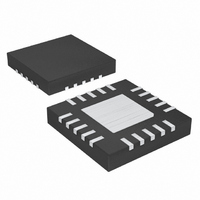MAX9768BETG+ Maxim Integrated Products, MAX9768BETG+ Datasheet - Page 13

MAX9768BETG+
Manufacturer Part Number
MAX9768BETG+
Description
IC AMP AUDIO 10W MONO D 24TQFN
Manufacturer
Maxim Integrated Products
Type
Class Dr
Datasheet
1.MAX9768BETG.pdf
(26 pages)
Specifications of MAX9768BETG+
Output Type
1-Channel (Mono)
Max Output Power X Channels @ Load
10W x 1 @ 8 Ohm
Voltage - Supply
4.5 V ~ 14 V
Features
Depop, I²C, Mute, Short-Circuit and Thermal Protection, Shutdown, Volume Control
Mounting Type
Surface Mount
Package / Case
24-TQFN Exposed Pad
Product
Class-D
Output Power
10 W
Thd Plus Noise
0.08 %
Operating Supply Voltage
4.5 V to 14 V
Supply Current
7 mA
Maximum Power Dissipation
2.22 W
Maximum Operating Temperature
+ 85 C
Mounting Style
SMD/SMT
Minimum Operating Temperature
- 40 C
Supply Voltage (max)
14 V
Supply Voltage (min)
4.5 V
Amplifier Class
D
No. Of Channels
1
Supply Voltage Range
4.5V TO 14V
Load Impedance
8ohm
Operating Temperature Range
-40°C To +85°C
Amplifier Case Style
TQFN
Rohs Compliant
Yes
Lead Free Status / RoHS Status
Lead free / RoHS Compliant
The MAX9768 features two fixed-frequency modes:
300kHz and 360kHz. Connect SYNC to GND to select
300kHz switching frequency; leave SYNC unconnected
to select 360kHz switching frequency. The frequency
spectrum of the MAX9768 consists of the fundamental
switching frequency and its associated harmonics (see
the Wideband Output Spectrum graphs in the Typical
Operating Characteristics ). For applications where
exact spectrum placement of the switching fundamen-
tal is important, program the switching frequency so the
harmonics do not fall within a sensitive frequency band
(Table 1). Audio reproduction is not affected by chang-
ing the switching frequency.
The MAX9768 features a unique spread-spectrum
mode that flattens the wideband spectral components,
improving EMI emissions that may be radiated by the
speaker and cables. This mode is enabled by setting
SYNC = V
quency varies randomly by ±7.5kHz around the center
frequency (300kHz). The modulation scheme remains
the same, but the period of the triangle waveform
changes from cycle to cycle. Instead of a large amount
of spectral energy present at multiples of the switching
frequency, the energy is now spread over a bandwidth
that increases with frequency. Above a few megahertz,
the wideband spectrum looks like white noise for EMI
purposes. A proprietary amplifier topology ensures this
does not corrupt the noise floor in the audio bandwidth.
The SYNC input allows the MAX9768 to be synchro-
nized to an external clock, or another Maxim Class D
amplifier, creating a fully synchronous system, minimiz-
ing clock intermodulation, and allocating spectral com-
ponents of the switching harmonics to insensitive
frequency bands. Applying a clock signal between
Table 1. Operating Modes
Unconnected Fixed-frequency modulation with f
Clocked
SYNC
GND
V
DD
DD
(Table 1). In SSM mode, the switching fre-
Fixed-frequency modulation with f
Spread-spectrum modulation with f
Fixed-frequency modulation with f
frequency
______________________________________________________________________________________
OSCILLATOR FREQUENCY (kHz)
Spread-Spectrum Mode
Fixed-Frequency Mode
Operating Modes
External Clock Mode
Amplifier with Volume Control
OSC
OSC
OSC
OSC
= 1200
= 1440
= external clock
= 1200 ±30
10W Mono Class D Speaker
1MHz and 1.6MHz to SYNC synchronizes the
MAX9768. The Class D switching frequency is equal to
one-fourth the SYNC input frequency.
SYNCOUT is equal to the SYNC input frequency and
allows several Maxim amplifiers to be cascaded. The
synchronized output minimizes interference due to
clock intermodulation caused by the switching spread
between single devices. The modulation scheme
remains the same when using SYNCOUT, and audio
reproduction is not affected (Figure 1). Current flowing
between SYNCOUT of a master device and SYNC of a
slave device is low as the SYNC input is high imped-
ance (typically 200kΩ).
Figure 1. Cascading Two Amplifiers
Fixed-frequency modulation with f
Fixed-frequency modulation with f
Spread-spectrum modulation with f
Fixed-frequency modulation with f
frequency / 4
SYNC
CLASS D FREQUENCY (kHz)
MAX9768
MAX9768
SYNCOUT
OUT+
OUT+
OUT-
OUT-
OSC
OSC
OSC
OSC
= 300
= 360
= external clock
= 300 ±7.5
13












